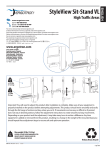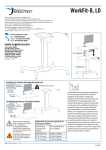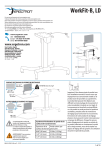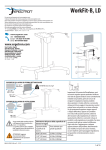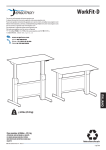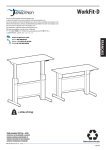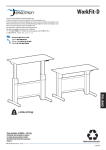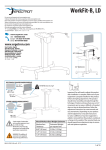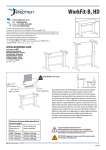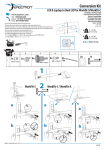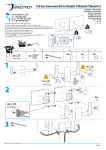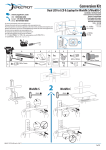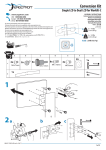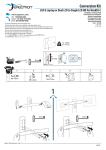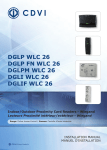Download Ergotron 61-080-085 flat panel wall mount
Transcript
Patient Room www.ergotron.com User's Guide - English Guía del usuario - Español Manuel de l’utilisateur - Français Gebruikersgids - Nederlands Benutzerhandbuch - Deutsch Guida per l’utente - Italiano Användarhandbok - svenska ユーザーガイド : 日本語 用户指南 : 汉语 A < 25 lbs (11.34 kg) B < 5 lbs (2.27 kg) C < 5 lbs (2.27 kg) A+B+C< 30lbs. (13.61 kg) Important! You will need to adjust this product after installation is complete. Make sure all your equipment is properly installed on the product before attempting adjustments. This product should move smoothly and easily through the full range of motion and stay where you set it. If movements are too easy or difficult or if product does not stay in desired positions, follow the adjustment instructions to create smooth and easy movements. Depending on your product and the adjustment, it may take many turns to notice a difference. Any time equipment is added or removed from this product, resulting in a change in the weight of the mounted load, you should repeat these adjustment steps to ensure safe and optimum operation. Max weight 30 lbs (13.61 kg) CAUTION: DO NOT EXCEED MAXIMUM LISTED WEIGHT CAPACITY. SERIOUS INJURY OR PROPERTY DAMAGE MAY OCCUR! Reduce.Reuse.Recycle 888-61-043-G-01 rev. C • 12/13 1 of 12 ENGLISH StyleView Sit-Stand VL ENGLISH Hazard Symbols Review These symbols alert users of a safety condition that demands attention. All users should be able to recognize and understand the significance of the following Safety Hazards if encountered on the product or within the documentation. Children who are not able to recognize and respond appropriately to Safety Alerts should not use this product without adult supervision! Symbol Signal Word Level of Hazard NOTE A NOTE indicates important information that helps you make better use of this product. CAUTION A CAUTION indicates either potential damage to hardware or loss of data and tells you how to avoid the problem. WARNING A WARNING indicates either potential for property damage, personal injury, or death. ELECTRICAL An Electrical indicates an impending electrical hazard which, if not avoided, may result in personal injury, fire and/or death. Safety WARNING: Because surfaces vary widely and the ultimate mounting method is out of Ergotron’s control, it is imperative that you consult with appropriate engineering, architectural or construction professional to ensure that your Ergotron mounting solution is mounted properly to handle applied loads. CAUTION: Make sure the wall mount bracket is level, flush and snug to the wall surface. DO NOT OVERTIGHTEN THE BOLTS. Important! You will need to adjust this product after installation is complete. Make sure all your equipment is properly installed on the product before attempting adjustments. This product should move smoothly and easily through the full range of motion and stay where you set it. If movements are too easy or difficult or if product does not stay in desired positions, follow the adjustment instructions to create smooth and easy movements. Depending on your product and the adjustment, it may take many turns to notice a difference. Any time equipment is added or removed from this product, resulting in a change in the weight of the mounted load, you should repeat these adjustment steps to ensure safe and optimum operation. 888-61-043-G-01 rev. C • 12/13 2 of 12 ENGLISH Components A 1x B C 1x D 4x 2x 1 M8 x 80mm 2 4x M8 1x 1x 3 4 1x 5 1x 4x 4x 14x 1x WALL MOUNTING TEMPLATE 6 1x 2x 4x M4 x 10mm M4 x 14mm 10x M3 x 5mm 1x 4x 7 1/4-20 x 1.5” 8 4x 2x 1x 4x M4 x 10mm Tools Needed HOLLOW WALL Ø 1/2” (13 mm) 2 1 WOOD 13mm 1/2" Ø 7/32" (5.5 mm) Ø 1/2" (13 mm) Stud Finder CONCRETE Ø 3/8" (9.5 mm) 888-61-043-G-01 rev. C • 12/13 3 of 12 ENGLISH Set-up Steps 3 Mounting Options Wood Stud Hollow Wall Concrete 5 1a b c Ø 1/2" (13 mm) MPLATE NTING TE OU WALL M 39” (991 mm) 6 d MPLATE NTING TE OU WALL M 39” (991 mm) 2a b 4x 1/4-20 x 1.5” 4x 1 2 3 4 7 888-61-043-G-01 rev. C • 12/13 4 of 12 ENGLISH Set-up Steps Wood Stud 1a b c d Ø 7/32" (5.5 mm) MPLATE NTING TE OU WALL M MPLATE NTING TE OU WALL M e Ø 1/2" (13 mm) MPLATE NTING TE OU WALL M 39” (991 mm) 39” (991 mm) 7/32” 5.5mm 3-1/8” 80mm 2a b 2x 1/4-20 x 1.5” 2x 1 2 3 4 13mm 2x M8 x 80mm 7 888-61-043-G-01 rev. C • 12/13 5 of 12 ENGLISH Set-up Steps Concrete 1a b c MPLATE NTING TE OU WALL M 39” (991 mm) 2a MPLATE NTING TE OU WALL M 3/8” 9.5-10mm 39” (991 mm) Ø 3/8" (9.5 mm) WARNING: Mounting holes must be at least 3-1/8” (80mm) deep and must be located within solid concrete, not mortar or covering material. If you drill into an area of concrete that is not solid, reposition mounting holes until both anchors can be fully inserted into solid concrete! b e 4x 3-1/8” 80mm 13mm M8 x 80mm c 4x M8 d WARNING: Anchors that are not fully set in solid concrete will not support the applied load resulting in an unstable, unsafe condition which could lead to personal injury and/or property damage. Consult a construction professional if you have any doubt about what this means in regard to your particular situation. 7 888-61-043-G-01 rev. C • 12/13 6 of 12 ENGLISH Set-up Steps 3a 6x b M3 x 5mm c 4x M3 x 5mm d 4x M4 x 10mm e 4a d f b c 4x 888-61-043-G-01 rev. C • 12/13 7 of 12 ENGLISH Set-up Steps 5 6a 21” (533 mm) b 4x M4 x 10mm c 2x M4 x 10mm M4 x 10mm 888-61-043-G-01 rev. C • 12/13 8 of 12 ENGLISH Set-up Steps 7 4x 2x 4x M4 x 10mm Leave enough slack in cable to allow full range of up-down motion. 8 4x M4 x 14mm 888-61-043-G-01 rev. C • 12/13 9 of 12 ENGLISH 9 Adjustment Step Important! You will need to adjust this product after installation is complete. Make sure all your equipment is properly installed on the product before attempting adjustments. This product should move smoothly and easily through the full range of motion and stay where you set it. If movements are too easy or difficult or if product does not stay in desired positions, follow the adjustment instructions to create smooth and easy movements. Depending on your product and the adjustment, it may take many turns to notice a difference. Any time equipment is added or removed from this product, resulting in a change in the weight of the mounted load, you should repeat these adjustment steps to ensure safe and optimum operation. a 13mm Increase Lift Strength If the mounted weight is too heavy or this product does not stay up when raised, then you'll need to increase Lift Strength: Decrease Lift Strength If the mounted weight is too light or this product does not stay down when lowered, then you'll need to decrease Lift Strength: b Loosen knob, tilt Display to desired position then retighten knob. 888-61-043-G-01 rev. C • 12/13 10 of 12 ENGLISH Adjustment Step c Increase Friction If this product moves too easily from side-to-side, then you'll need to increase friction: Decrease Friction If this product is too difficult to move from side-to-side, then you'll need to decrease friction: d 1/2" 1/2" Increase Friction If this product moves too easily from side-to-side, then you'll need to increase friction: Decrease Friction If this product is too difficult to move from side-to-side, then you'll need to decrease friction: e 1/2" Increase Friction If this product moves too easily from side-to-side, then you'll need to increase friction: Decrease Friction If this product is too difficult to move from side-to-side, then you'll need to decrease friction: f 888-61-043-G-01 rev. C • 12/13 11 of 12 ENGLISH Set Your Workstation to Work For YOU! Configure su estación de trabajo para que trabaje para USTED. Ajustez votre station de travail en fonction de VOS besoins ! Richten Sie Ihren Arbeitsplatz so ein, dass er für SIE arbeitet! Stel uw werkstation zo in dat het voor U werkt! Approntare la stazione di lavoro nella posizione ergonomica ottimale. 一人ひとりにピッタリのワークステーション! 按照您自身的需要设置工作站! Learn more about ergonomic computer use at: Más información sobre el uso ergonómico de ordenadores: Apprenez-en plus sur l’utilisation ergonomique d’un ordinateur sur : Weitere Informationen zur ergonomischen Computernutzung finden Sie unter: Leer meer over ergonomisch computergebruik op: Per ulteriori informazioni sull’uso ergonomico del computer: 人間工学的なコンピュータの使用法については次のサイトを参照してください 想进一步了解以符合人体工程学的方式使用计算机的知识,请访问: www.computingcomfort.org Height Position top of screen slightly below eye level. Position keyboard at about elbow height with wrists flat. Distance Position screen an arm's length from face—at least 20” (508mm). Position keyboard close enough to create a 90˚ angle in elbow. Angle Tilt screen to eliminate glare. Tilt the keyboard back 10° so that your wrists remain flat. To Reduce Fatigue Breathe - Breathe deeply through your nose. Blink - Blink often to avoid dry eyes. Break • 2 to 3 minutes every 20 minutes • 15 to 20 minutes every 2 hours. Altura Coloque el borde superior de la pantalla ligeramente por debajo de la altura de sus ojos. Coloque el teclado aproximadamente a la altura de los codos con las muñecas planas. Distancia Coloque la pantalla a una distancia de un brazo desde la cara, esto es, unos 50 cm (20 pulgadas). Coloque el teclado lo suficientemente cerca para que el codo forme un ángulo de 90º. Ángulo Incline la pantalla para eliminar los reflejos. Incline el teclado 10º hacia atrás para que las muñecas sigan en posición plana. Para reducir la fatiga Respirar - Respire hondo por la nariz. Parpadear - Parpadee a menudo para que no se sequen los ojos. Descansar • 2 o 3 minutos cada 20 minutos • 15 o 20 minutos cada 2 horas. Hauteur Positionnez l’écran du haut légèrement en dessous du niveau du regard. Positionnez le clavier à peu près à la même hauteur que vos coudes, pour que vos poignets soient à plat. Distance Positionnez l’écran à un bras de distance de votre visage, à au moins 508 mm (20 pouces). Positionnez le clavier assez près pour que vos coudes forment un angle de 90°. Angle Inclinez l’écran pour ne pas être ébloui. Inclinez le clavier vers l’arrière de 10° pour que vos poignets soient à plat. Pour réduire la fatigue Respirez - Respirez profondément par votre nez. Clignez des yeux - Clignez souvent des yeux pour ne pas avoir les yeux secs. Faites des pauses • 2 à 3 minutes toutes les 20 minutes • 15 à 20 minutes toutes les 2 heures. Höhe Positionieren Sie die obere Kante des Bildschirms knapp unter Augenhöhe. Positionieren Sie die Tastatur bei flach aufgelegten Handgelenken auf Ellenbogenhöhe. Abstand Positionieren Sie den Bildschirm mindestens eine Armlänge (50 cm) von Ihrem Gesicht entfernt. Positionieren Sie die Tastatur nahe genug, um einen Ellenbogenwinkel von 90 ˚ zu ermöglichen. Winkel Neigen Sie den Bildschirm so, dass ein Spiegeleffekt vermieden wird. Neigen Sei die Tastatur um 10 ° nach hinten, sodass Ihre Handgelenke flach aufliegen. Vermeiden von Ermüdungserscheinungen Atmen - Atmen Sie tief durch die Nase ein und aus. Blinzeln - Blinzeln Sie so oft wie möglich, um trockene Augen zu vermeiden. Pausen • Machen Sie alle 20 Minuten eine Pause von 2-3 Minuten • Machen Sie alle 2 Stunden eine Pause von 15-20 Minuten. Hoogte Zet de bovenkant van het scherm iets boven ooghoogte. Plaats het toetsenbord op ongeveer ellebooghoogte met de polsen plat. Afstand Plaats het scherm op een armlengte van uw gezicht — op ten minste 508 mm (20 in). Zet uw toetsenbord zo dichtbij dat u een hoek van 90° in de ellebogen hebt. Hoek Kantel het scherm om weerspiegeling te elimineren. Kantel het toetsenbord 10° naar achteren, zodat uw polsen plat blijven liggen. Om vermoeidheid te verminderen Ademen - Adem diep door uw neus in en uit. Knipperen - Knipper regelmatig om droge ogen te vermijden. Pauzes nemen • 2 tot 3 minuten elke 20 minuten • 15 tot 20 minuten elke 2 uur. Altezza Posizionare la parte superiore dello schermo leggermente sotto il livello degli occhi. Posizionare la tastiera circa all’altezza dei gomiti, in modo che i polsi siano piatti. Distanza Posizionare lo schermo a un braccio di distanza dal viso, almeno a 20" (508 mm) di distanza. Posizionare la tastiera affinché sia abbastanza vicina da costringere i gomiti a un angolo di 90˚. Angolazione Inclinare lo schermo in modo da eliminare i riflessi. Inclinare la tastiera indietro di 10° in modo che i polsi rimangano piatti. Per ridurre l’affaticamento Respirazione - Respirare profondamente dal naso. Battito delle palpebre - Battere spesso le palpebre per evitare che gli occhi si asciughino. Pause • Fare una pausa di 2 - 3 minuti ogni 20 minuti • Fare una pausa di 15 - 20 minuti ogni 2 ore. 高さ スクリーンの上端が目よりわずかに下に来るようにします。 キーボードが、手首を水平に伸ばした状態でひじとほぼ同じ高さに来るようにします。 距離 スクリーンを顔から腕の長さ分(少なくとも508mm)離します。 ひじが直角になる位置にキーボードを置きます。 角度 反射光をなくすようにスクリーンの角度を調整します。 キーボードを後方に 10° 傾けて、手首が水平になるようにします。 疲れを軽減する方法 呼吸 - 鼻から深く呼吸します。 まばたき - 目の乾燥を防ぐために頻繁にまばたきしてく ださい。 休憩 • 20分ごとに2~3分 • 2時間ごとに15~20分 高度 屏幕顶端的位置要稍低于视线高度。 将键盘放置在大约肘部的高度并且手腕要能放平。 距离 将屏幕摆放在距离面部一臂长的位置——至少 508mm (20”)。 键盘的位置要够近,以使肘部形成直角。 角度 倾斜屏幕以消除眩光。 将键盘向后倾斜 10 度,使手腕能保持放平。 为了减轻疲劳 呼吸 - 通过鼻子深呼吸。 眨眼 - 经常眨眼可避免眼睛干涩。 休息 • 每隔 20 分钟休息 2 至 3 分钟 • 每隔 2 小时休息 15 至 20 分钟. 888-61-043-G-01 rev. C • 12/13 12 of 12












